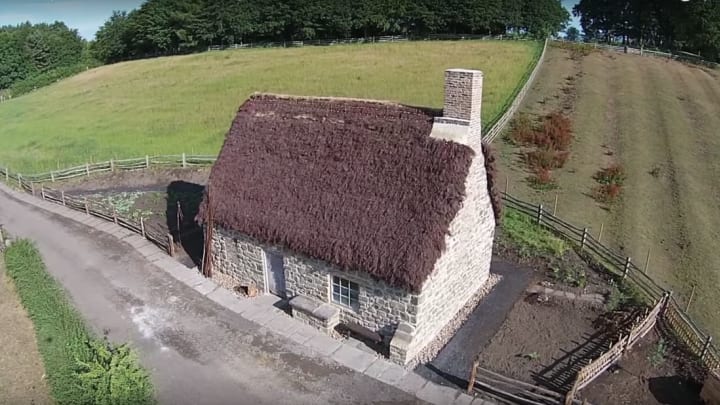Joe the Quilter led a quiet life in the English countryside, where he tended his gooseberry garden and earned something of a reputation as a hermit. Born Joseph Hedley, he had earned his moniker by attaining “a greater proficiency in quilting than any ever known in the north of England,” according to a postcard recently spotlighted by Museum Crush. When he wasn’t at home in Warden, Northumberland, he was traveling around the country selling his homemade quilts, some of which were shipped across the pond to America.
Old Joe was well known, and well-liked. It was quite a shock, then, when he was found murdered in his home.
The quilter was last seen alive on the evening of January 3, 1826. A few days later, when they hadn't heard from him, concerned neighbors broke down his door. They found the walls of his cottage—which had been ransacked—stained with blood. A bloody handprint marked a quilt that was stretched out in a frame. Joe's body was found in the outhouse; his head, face, and neck had been slashed 44 times by a sharp object. He was 76 years old at the time of his death.
“The only possible motive for the crime was considered to have been a hope of securing money, as it was foolishly believed that old Joe was rich, although he was receiving parish relief,” according to an 1891 issue of The Monthly Chronicle of North-country Lore and Legend.
Although rewards were offered for information leading to an arrest, no one was ever brought to justice, and the event became another one of the country’s unsolved murders. Now, nearly two centuries later, Joe’s story is once again being told thanks to the Beamish Museum, which has rebuilt a version of Joe’s cottage.
Although Joe’s cottage was torn down in 1872, museum staff and community members unearthed some clues about what his humble abode may have looked like during a recent archaeological dig. The model was built with stones from Joe’s original home, and the interior furnished with items similar to ones he once owned. The aforementioned postcard, as well as historic records of an auction that was held to sell Joe’s belongings after his death, aided museum staff in this process.
The cottage, which is now open to the public, is part of the museum’s $13.9 million “Remaking Beamish” project. The museum focuses on Northeastern England’s history, particularly during the key decades of the 1820s, 1900s, and 1940s. The exhibition of Joe’s cottage not only tells the story of his personal history and demise, but also highlights the history of quilting and England's cottage industry boom in the early 1800s.
Museum director Richard Evans told Museum Crush that the “beautifully-crafted, heather-thatched cottage gives us a rare chance to understand what everyday life was like in the Northeast during the early part of the 19th century.” It also brings visitors just a little closer to one of the area's most terrible historical crimes.
[h/t Museum Crush]
